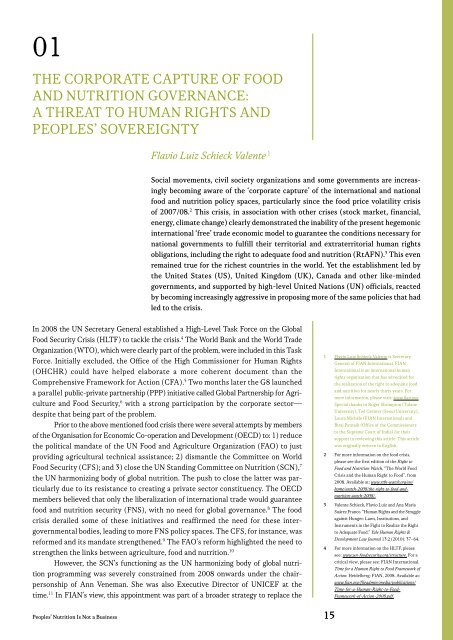RIGHT TO FOOD AND NUTRITION WATCH
1iNBHTY
1iNBHTY
Create successful ePaper yourself
Turn your PDF publications into a flip-book with our unique Google optimized e-Paper software.
01<br />
THE CORPORATE CAPTURE OF <strong>FOOD</strong><br />
<strong>AND</strong> <strong>NUTRITION</strong> GOVERNANCE:<br />
A THREAT <strong>TO</strong> HUMAN <strong>RIGHT</strong>S <strong>AND</strong><br />
PEOPLES’ SOVEREIGNTY<br />
Flavio Luiz Schieck Valente 1<br />
Social movements, civil society organizations and some governments are increasingly<br />
becoming aware of the ‘corporate capture’ of the international and national<br />
food and nutrition policy spaces, particularly since the food price volatility crisis<br />
of 2007/08. 2 This crisis, in association with other crises (stock market, financial,<br />
energy, climate change) clearly demonstrated the inability of the present hegemonic<br />
international ‘free’ trade economic model to guarantee the conditions necessary for<br />
national governments to fulfill their territorial and extraterritorial human rights<br />
obligations, including the right to adequate food and nutrition (RtAFN). 3 This even<br />
remained true for the richest countries in the world. Yet the establishment led by<br />
the United States (US), United Kingdom (UK), Canada and other like-minded<br />
governments, and supported by high-level United Nations (UN) officials, reacted<br />
by becoming increasingly aggressive in proposing more of the same policies that had<br />
led to the crisis.<br />
In 2008 the UN Secretary General established a High-Level Task Force on the Global<br />
Food Security Crisis (HLTF) to tackle the crisis. 4 The World Bank and the World Trade<br />
Organization (W<strong>TO</strong>), which were clearly part of the problem, were included in this Task<br />
Force. Initially excluded, the Office of the High Commissioner for Human Rights<br />
(OHCHR) could have helped elaborate a more coherent document than the<br />
Comprehensive Framework for Action (CFA). 5 Two months later the G8 launched<br />
a parallel public-private partnership (PPP) initiative called Global Partnership for Agriculture<br />
and Food Security, 6 with a strong participation by the corporate sector—<br />
despite that being part of the problem.<br />
Prior to the above mentioned food crisis there were several attempts by members<br />
of the Organisation for Economic Co-operation and Development (OECD) to: 1) reduce<br />
the political mandate of the UN Food and Agriculture Organization (FAO) to just<br />
providing agricultural technical assistance; 2) dismantle the Committee on World<br />
Food Security (CFS); and 3) close the UN Standing Committee on Nutrition (SCN), 7<br />
the UN harmonizing body of global nutrition. The push to close the latter was particularly<br />
due to its resistance to creating a private sector constituency. The OECD<br />
members believed that only the liberalization of international trade would guarantee<br />
food and nutrition security (FNS), with no need for global governance. 8 The food<br />
crisis derailed some of these initiatives and reaffirmed the need for these intergovernmental<br />
bodies, leading to more FNS policy spaces. The CFS, for instance, was<br />
reformed and its mandate strengthened. 9 The FAO’s reform highlighted the need to<br />
strengthen the links between agriculture, food and nutrition. 10<br />
However, the SCN’s functioning as the UN harmonizing body of global nutrition<br />
programming was severely constrained from 2008 onwards under the chairpersonship<br />
of Ann Veneman. She was also Executive Director of UNICEF at the<br />
time. 11 In FIAN’s view, this appointment was part of a broader strategy to replace the<br />
1 Flavio Luiz Schieck Valente is Secretary<br />
General of FIAN International. FIAN<br />
International is an international human<br />
rights organization that has advocated for<br />
the realization of the right to adequate food<br />
and nutrition for nearly thirty years. For<br />
more information, please visit: www.fian.org.<br />
Special thanks to Roger Shrimpton (Tulane<br />
University), Ted Greiner (Seoul University),<br />
Laura Michéle (FIAN International) and<br />
Biraj Patnaik (Office of the Commissioners<br />
to the Supreme Court of India) for their<br />
support in reviewing this article. This article<br />
was originally written in English.<br />
2 For more information on the food crisis,<br />
please see the first edition of the Right to<br />
Food and Nutrition Watch, “The World Food<br />
Crisis and the Human Right to Food”, from<br />
2008. Available at: www.rtfn-watch.org/en/<br />
home/watch-2008/the-right-to-food-andnutrition-watch-2008/.<br />
3 Valente Schieck, Flavio Luiz and Ana María<br />
Suárez Franco. “Human Rights and the Struggle<br />
against Hunger: Laws, Institutions, and<br />
Instruments in the Fight to Realize the Right<br />
to Adequate Food.” Yale Human Rights &<br />
Development Law Journal 13:2 (2010): 37–64.<br />
4 For more information on the HLTF, please<br />
see: www.un-foodsecurity.org/structure. For a<br />
critical view, please see: FIAN International.<br />
Time for a Human Right to Food Framework of<br />
Action. Heidelberg: FIAN, 2008. Available at:<br />
www.fian.org/fileadmin/media/publications/<br />
Time-for-a-Human-Right-to-Food-<br />
Framework-of-Action-2008.pdf.<br />
Peoples’ Nutrition Is Not a Business 15


